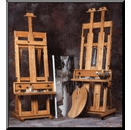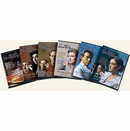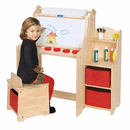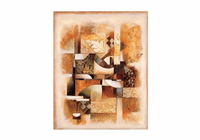COLLAGE - A TEXTURAL TREAT
Collage is a fascinating form of art creation in which different textures and colors work within a design and convey an idea or emotion. Artists who create collage works use many different materials in their designs and by doing so have a limitless source of elements for their work. It is both fun and rewarding to use not only new materials but also found objects in these works. Collecting discarded materials is an active pastime of most collagists.
The size of a work is an important factor when choosing articles for inclusion in any collage. Severely textured papers, boards, corrugated and the like might be best left to large scale works while soft, subtle textures work exceptionally well on small works. Greeting cards are a great jumping off point for the beginner. With a few snips of Strathmore Chromolux Pearlescent stock, shiny Color Cover Sheets, or Mirri Sheets, richly colored craft/drawing paper and a small snippet of lace you are set to create an original card that is both beautiful and personal (Strathmore makes many rich tones perfect for collage work in their Textured Sheets, Ridge Acid-Free Sheets, 500 Series Pure Papers).
Somewhere in the unwritten rules of design is a suggestion that works of uneven numbers of elements are usually most interesting. There is also a suggestion about using different sizes for each element, or sizes that appear to be graduated. Why not use the most simple arrangement, three patches of tone and texture to create a small sample of collage. To begin, assemble the materials needed: glue stick, sheets of bright, rich paper, perhaps a metallic gift wrap scraps, lace or even Strathmore Natural Corduroy Paper or old box flaps and a blank greeting card and envelope.
Study the face of a blank greeting card, paying attention to it's vertical of horizontal configuration. With that in mind, tear or cut a piece of dark toned paper and glue it to the face of the card. Set it at an angle for interest rather than centered or aligned with the sides of the card. Add a medium, contrasting piece and end with a small, glitzy piece for a spark of visual surprise.
Add a couple of small snippets to the back of the envelope and you have a coordinated set.
For medium to large collages, require a more substantial base on which to work and use larger color sections. Great base material for larger pieces includes Strathmore Bristol, Strathmore 300, 400 or 500 Series Watercolor paper and Museum Mounting Boards.
Larger shapes with torn edges and unusual, irregular shapes catch the eye of the viewer and engage his/her mind in the process of viewing the collage. For these larger works, use super textures such as painted, ripped corrugated, painted Corduroy or Ridge sheets, heavy drawing paper or watercolor paper with stamped images - cut out and elevated off the surface with foam board or other thick material. There is no wrong move in collage. It is good, however, to use fewer distracting elements. Metallics, fake gemstones, puff paint, thick squeezes of paint and even hand stitching with cording or string add extra textures and stimulate curiosity. There is virtually no limit to the things you can include in and on your collage work. Twigs, fabrics, stones and pebbles, wire, metal scrap, foils, buttons, old jewelry...nothing is off bounds.
To present a collage and to protect it during transport and display, it is good to wrap the finished work with acetate or to mat and frame the artwork. If you design your collage with a wide border around its elements, adding an elevated mat is easy and is a very professional presentation. Do this by cutting a mat with a pleasing border width and glue foam board strips to the backside. If you align your strips closely and neatly, no frame is needed. Stack the elevated mat on the art and wrap the entire package in acetate. Voila! Instant sellable art or a great gift.
Think about collage work when you are ready for an interesting and rewarding creative outlet that uses every kind of art material from top quality papers to recycled gift wrap and old corrugated boxes. You'll be glad you did.
The size of a work is an important factor when choosing articles for inclusion in any collage. Severely textured papers, boards, corrugated and the like might be best left to large scale works while soft, subtle textures work exceptionally well on small works. Greeting cards are a great jumping off point for the beginner. With a few snips of Strathmore Chromolux Pearlescent stock, shiny Color Cover Sheets, or Mirri Sheets, richly colored craft/drawing paper and a small snippet of lace you are set to create an original card that is both beautiful and personal (Strathmore makes many rich tones perfect for collage work in their Textured Sheets, Ridge Acid-Free Sheets, 500 Series Pure Papers).
Somewhere in the unwritten rules of design is a suggestion that works of uneven numbers of elements are usually most interesting. There is also a suggestion about using different sizes for each element, or sizes that appear to be graduated. Why not use the most simple arrangement, three patches of tone and texture to create a small sample of collage. To begin, assemble the materials needed: glue stick, sheets of bright, rich paper, perhaps a metallic gift wrap scraps, lace or even Strathmore Natural Corduroy Paper or old box flaps and a blank greeting card and envelope.
Study the face of a blank greeting card, paying attention to it's vertical of horizontal configuration. With that in mind, tear or cut a piece of dark toned paper and glue it to the face of the card. Set it at an angle for interest rather than centered or aligned with the sides of the card. Add a medium, contrasting piece and end with a small, glitzy piece for a spark of visual surprise.
Add a couple of small snippets to the back of the envelope and you have a coordinated set.
For medium to large collages, require a more substantial base on which to work and use larger color sections. Great base material for larger pieces includes Strathmore Bristol, Strathmore 300, 400 or 500 Series Watercolor paper and Museum Mounting Boards.
Larger shapes with torn edges and unusual, irregular shapes catch the eye of the viewer and engage his/her mind in the process of viewing the collage. For these larger works, use super textures such as painted, ripped corrugated, painted Corduroy or Ridge sheets, heavy drawing paper or watercolor paper with stamped images - cut out and elevated off the surface with foam board or other thick material. There is no wrong move in collage. It is good, however, to use fewer distracting elements. Metallics, fake gemstones, puff paint, thick squeezes of paint and even hand stitching with cording or string add extra textures and stimulate curiosity. There is virtually no limit to the things you can include in and on your collage work. Twigs, fabrics, stones and pebbles, wire, metal scrap, foils, buttons, old jewelry...nothing is off bounds.
To present a collage and to protect it during transport and display, it is good to wrap the finished work with acetate or to mat and frame the artwork. If you design your collage with a wide border around its elements, adding an elevated mat is easy and is a very professional presentation. Do this by cutting a mat with a pleasing border width and glue foam board strips to the backside. If you align your strips closely and neatly, no frame is needed. Stack the elevated mat on the art and wrap the entire package in acetate. Voila! Instant sellable art or a great gift.
Think about collage work when you are ready for an interesting and rewarding creative outlet that uses every kind of art material from top quality papers to recycled gift wrap and old corrugated boxes. You'll be glad you did.
Copyright © 2002-2025 Madison Art Shop™ LLC. All Rights Reserved.

















